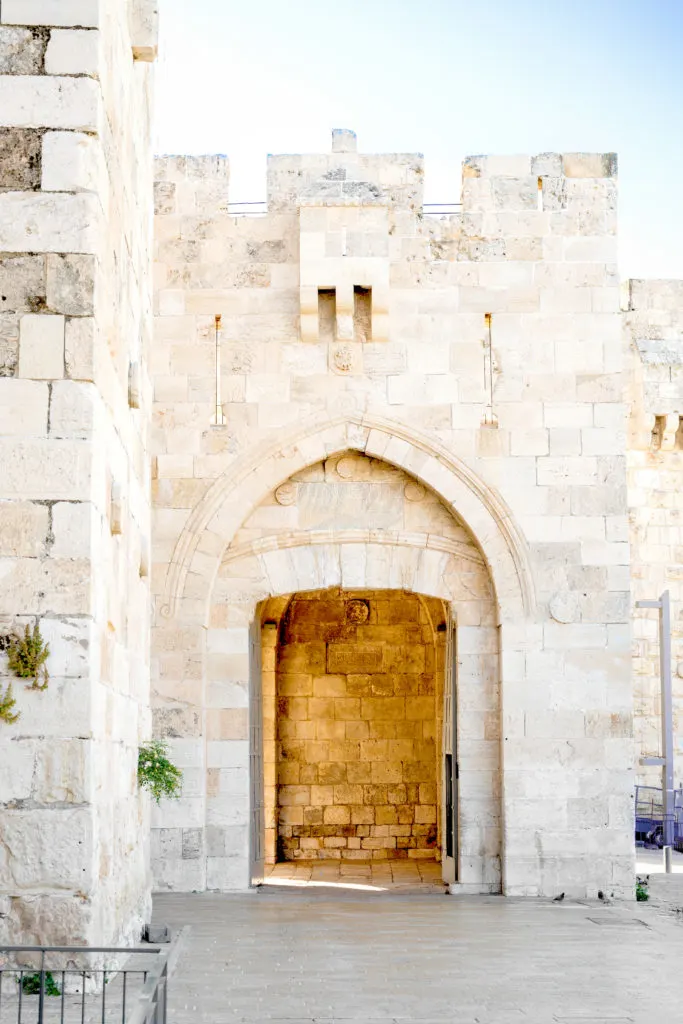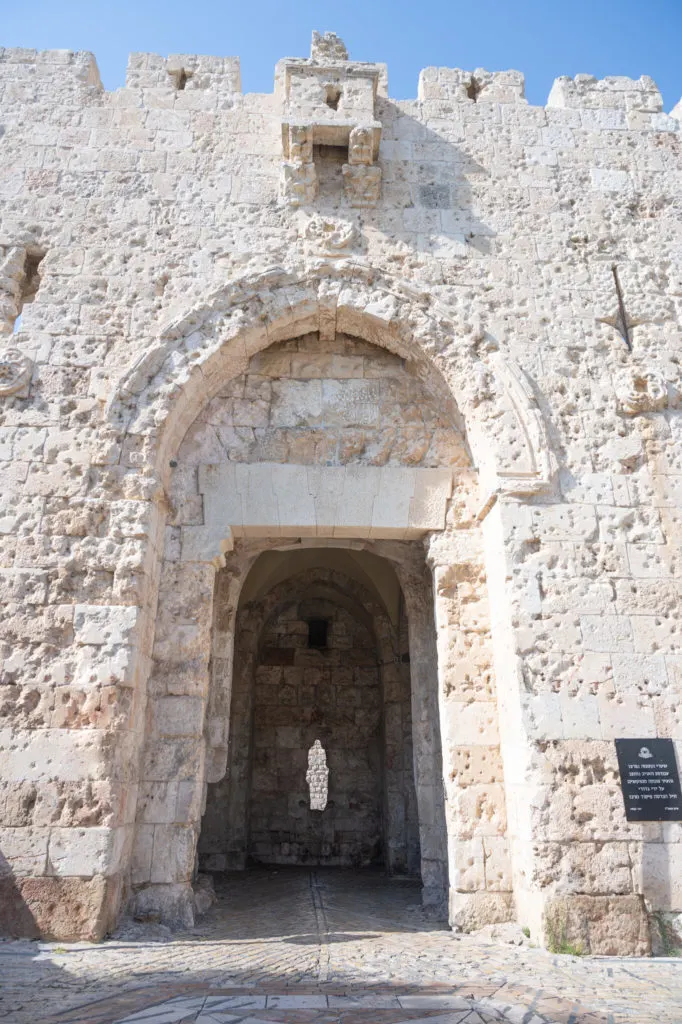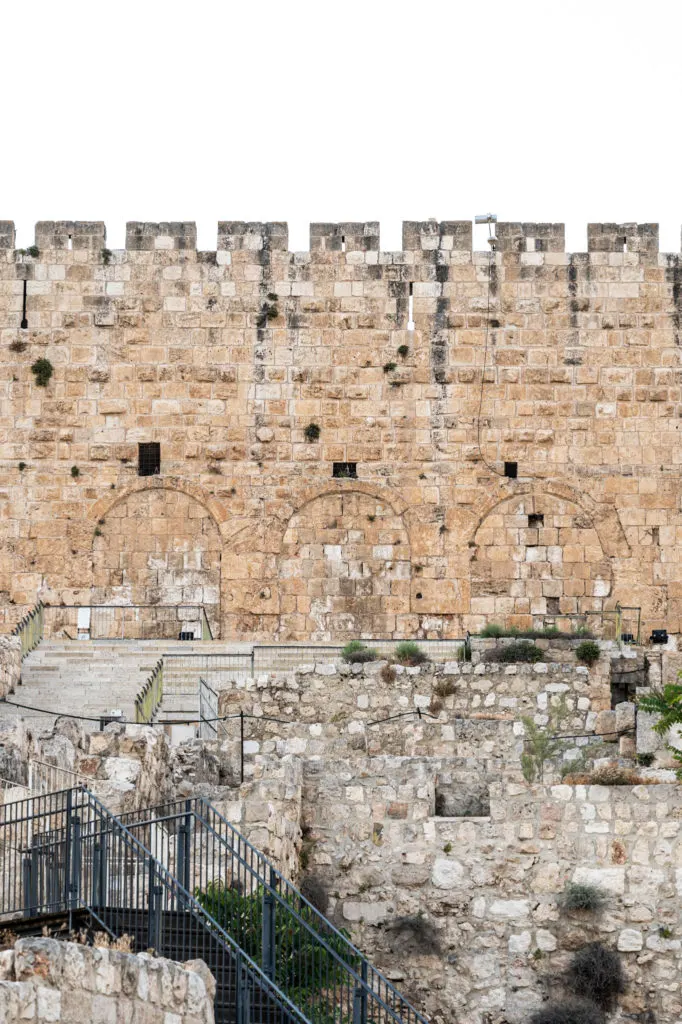Old City of Jerusalem Gates are mostly built in the wall that encompasses the Old City of Jerusalem.
Today’s wall has been standing for around 480 years, and even though it is the newest of the city walls, it follows the route of the walls that have encompassed the city since ancient times.
There are seven open gates in the Old City and another five closed gates, all created at various points in time.
JAFFA GATE

Jaffa Gate was completed in 1538 as part of the rebuilding of the Old City walls by Suleiman the Magnificent.
It is called Jaffa Gate because, as it does today, it is connected to Jaffa Road which in turn stretched all the way to the port in Old City of Jaffa. This way travelers and pilgrims took to the Old City.
The gate has the shape of a medieval gate tower with an L-shaped entryway which was secured at both ends with heavy doors. This shape was a classical defensive measure designed to slow down oncoming attackers.
Next to the Gate is a large breach in the wall was created in 1898 by the Ottoman authorities in order to honor German emperor Wilhelm II who came through them.
The demolished wall segment moved to citadel moat, a portion of which was filled in, to create a ramp.
The breach and the ramp leading up to it are now allowing cars to access the Old City from the west.
Jaffa Gate is one of the gates of the Old City and the most commonly used entrance due to it’s connection to Jaffa Road.
Near this gate you can tour the Tower of David Museum and begin the Ramparts Walk.
Outside the gate, is a stone-paved courtyard from which one can admire views of modern Jerusalem.
You can see Montefiore’s Windmill and his Mishkenot Sha’ananim neighborhood, the red-tile roof of Yemin Moshe neighborhood, and the King David Hotel.
From here you can enter Mamilla Mall, which is a shopping street and the only open-air mall which leads back to town.
ZION GATE

Zion Gate, also know as King David’s Gate, was built by the Ottomans as a direct continuation of the Street of the Jews also known the Cardo and leads to Mount Zion.
Six sentry towers were erected in the southern segment of the wall, four of them situated in the Mount Zion section.
On May 13, 1948, as the British Army withdrew from Jerusalem, a major from the Suffolk Regiment presented Mordechai Weingarten with the key for the Zion Gate.
The bullet holes on the facade of the gate are remnants Israel’s War of Independence that took place later that year.
Mount Zion which located next to Zion gate is where you will find the closest parking space to the Jewish quarter and the Western Wall for non-residents.
Enter the gate and walk to your right, downhill towards the Jewish Quarter and the Western Wall an approx 5-10 minute walk along the southern Walls of the Old City.
LIONS GATE
Loins Gate gets it’s name by the four lions carved into the wall above it, two on the left and two on the right.
Legend has it that Suleiman’s predecessor Selim I dreamed of lions that were going to eat him because of his plans to level the city. He was spared only after promising to protect the city by building a wall around it.
Above the lion embossments there are additional decorations: flowers and arches are embossed between the embrasures, and above them an inscription that commemorates the construction of the city’s wall by Suleiman the Magnificent.
On the upper part of the gate a terrace stands out, known as a “Mashikoli”. From this small terrace one can observe the outline of the wall, and possibly spill hot oil on intruders.
Originally, it was an L-shaped gate, like Jaffa gate, to protect the city from innovators, today it is a straight gate that enables the entrance of vehicles.
During the Six-Day war in 1967 the IDF paratroopers entered the city via this gate on their way to the Temple Mount and reunification of Jerusalem.
This gate is also the start of the traditional Christian observance walking down the Via Dolorosa begins at the Lions’ Gate.
DUNG GATE
The name Dung Gate comes from the mistranslated from the which would be Trash Gate which appears in the Book of Nehemiah.
It is probably named after the residue that was taken from the Jewish Temple into the Valley of Hinnom, where it was burned.
This ancient “Dung Gate” may not have been in the same location as the today’s gate.
This was the entrance to the Old City and the Western Wall used by Israeli soldiers during the Six-Day War when Jerusalem was reunified in 1967.
The gate was built as a small postern gate by the Ottomans designed for pedestrians and pack animals to pass through. However, it was widened for vehicular traffic in 1952 by the Jordanians, and again in 1985 by Israel.
Those who enter from the Dung Gate could see at their right the Jerusalem Archaeology Park and the Davidson Center.
DAMASCUS GATE
Damascus Gate, or the Nablus Gate, connects to a highway leading out to Nablus, and from there, in times past, to the capital of Syria, Damascus. The gate was built by Suleiman the Magnificent.
This gate leads into the the Muslim and Christian Quarters and has easy access to the Jerusalem light rail.
Directly below the existing gate of is an older gate dating back to the time of the Roman Emperor Hadrian. In front of which was once a Roman era, a stone-paved courtyard , and at its center stood the statue of the emperor.
HADRIAN’S GATE
While Hadrian’s Gate (which as no official name) was the main gate to the city during the Roman and Byzantine rule, today it leads to the Roman Plaza Museum.
Hadrian’s Gate was built as a free-standing triumphal gate.
It was only sometime towards the end of the 3rd or the very beginning of the 4th century that protective walls were built around Jerusalem, connecting to the existing gate.
The central arch was some 40 meters wide and about 20 meters tall with identical, more modest, entrances to the city on either side.
It was here that anyone passing through the gate into the city, which was a paved road, would need to pay taxes to enter.
In the square behind the gate stood a Roman victory column topped by a statue of Emperor Hadrian. This can still be seen depicted on the 6th-century Madaba Map located in the Cardo.
This gate was the smaller entrance that stood on the right.
On the lintel of this gate is inscribed the city’s Roman name after 130 CE, Aelia Capitolina.
Until the latest excavations some researchers believed that Hadrian’s gate was preceded by one erected by Agrippa I as part of what Josephus called the Third Wall.
The Roman gate remained in use during the Byzantine and Crusader periods.
Its side entrances were blocked during the Byzantine and Early Arab periods.
Later the Crusaders built a new, fortified gate at a much higher level, unwittingly preserving the remains of the Roman gate below it.
HEROD’S GATE
Herod’s Gate, or Flowers Gate, is one of the newest gates of Jerusalem, built in 1875, which opens from a wall tower. While it is simple, it has floral design near the top of the gate.
The gate’s name was derived from a mistaken belief held by pilgrims that a nearby building was at one time the palace of Herod Antipas.
At the time when Suleiman the Magnificent built the city walls, it was just a a small wicket gate and rarely opened.
Formerly, area gate led to the residential known as Bezetha, or “New City,”, settled during the late Second Temple period to accommodate Jerusalem’s growing population. Today this area is the Muslim Quarter.
At the time when Suleiman the Magnificent built the city walls, a small wicket gate was situated in the eastern, lateral wall of the tower, which was rarely opened.
By 1875, in order to provide a passageway to the new neighborhoods which were beginning to develop north of the Old City, the Ottomans opened a new gate in the northern, frontal wall of the tower closed the original lateral gate.
GOLDEN GATE
Golden Gate, or Sha’ar HaRachamim in Hebrew meaning Gate of Mercy, is the only gate leading to the Temple Mount and one of only two that used to offer access into the city from that side.
The gate has been walled up since medieval times. However, the date of its construction is disputed and no archaeological work is allowed at the gatehouse, but opinions are shared between a late Byzantine and an early Umayyad date.
In the Mishnah (Middot 1:3), the eastern gate of the second Temple compound is called the Shushan Gate.
If the Golden Gate does preserve the location of the Shushan Gate, this would make it the oldest of the current gates in Jerusalem’s Old City Walls.
According to Jewish tradition, the Shekhinah, or Divine Presence, used to appear through the eastern Gate, and will appear again when the Messiah comes (Ezekiel 44:1–3) and a new gate replaces the present one.
This might why Jews used to pray in medieval times for mercy at the former gate at this location.
Another possible reason being that in the Crusader period, when this habit was first documented, they were not allowed into the city where the Western Wall is located.
Hence the name “Gate of Mercy.”
Suleiman the Magnificent rebuilt the Golden Gate together with the city walls, but walled it up in 1541, and it stayed that way.
One thought is that Suleiman may have taken this decision purely for defensive reasons.
However, since there is a Jewish tradition that this is the gate through which the Messiah, it is possible that he sealed off the gate to prevent a false Messiah coming through entrance.
The Ottomans also built a cemetery in front of the gate to prevent a false, Prophet Elijah – who is supposed to announce the arrival of the Messiah, from passing through the gate.
This is because, according to Islamic teaching Elijah is a descendant of Aaron, making him a priest or kohen, and knowing that a Jewish kohen is not permitted to enter a cemetery.
However, a Kohen is permitted to enter a cemetery in which either Jews or non-Jews are buried, such as the one outside the Golden Gate, as long as certain laws or Halakha regarding purity are followed.
NEW GATE
The New Gate was built in 1889 to provide direct access between the Christian Quarter and the new neighborhoods then going up outside the walls.
The arched gate is decorated with crenelated stonework. The New Gate was built at the highest point of the present wall.
It should not be confused with the New Gate of the Second Temple complex mentioned in the Book of Jeremiah that served as entrance to the Great Sanhedrin’s Hall of Hewn Stones, and was previously called the Benjamin Gate.
The Huldah Gates

The Huldah Gates were Gates leading to Temple in the Hasmonean period and were named as such in the Mishnah.
However, the term is currently being used for the remains of two later sets of gates, the Triple Gate and the Double Gate, known together as the Huldah Gates.
They were built as part of the much extended Herodian Temple Mount, situated in Jerusalem’s Old City.
Both sets of gates were set into the Southern Wall of the Temple compound and gave access to the Temple Mount esplanade by means of underground vaulted ramps.
Both have been walled up in the Middle Ages.
The 19th century excavations of the area by Charles Warren discovered an erratic series of passageways under the triple gate, some leading below the wall and beyond the Mount’s southern edge.
The purpose and age of these passages are unknown, and more recent archaeologists have not been allowed to investigate due to the political volatility of the site.
Tanners’ Gate
Tanners’ Gate is located near the Dung Gate in the Jewish Quarter. It is the second oldest entrance into the Old City.
Probably built in the 12th Century by the Crusaders near a cattle market – hence the name – as pedestrian gate.
Suleiman the Magnificant filled in Tanners’ Gate when he built the current Old City walls, gates, and towers.
The gate was discovered during archaeological investigations, partially reconstructed and interpreted as part of the Beth Shalom Garden.
It was studied further during excavations along the Old City walls in 1995. The Jerusalem Foundation supported archaeological excavation and restoration of the gate and construction of an adjoining plaza into the Old City.
The restored gate was the first new opening into the Old City walls since 1887.
Single Gate
Single Gate is from the Herodian Period but is closed off. It is in the southern wall of Temple Mount and led to the underground area of the Temple Mount known as Solomon’s Stables.
Excavators’ Gate
Excavation Gate was built 705–715 but walled up when the Suleiman the Magnificentwall was built the current Old City Wall.
It was reopened and rebuilt by archaeologists led by Benjamin Mazar and Meir Ben-Dov in 1968.